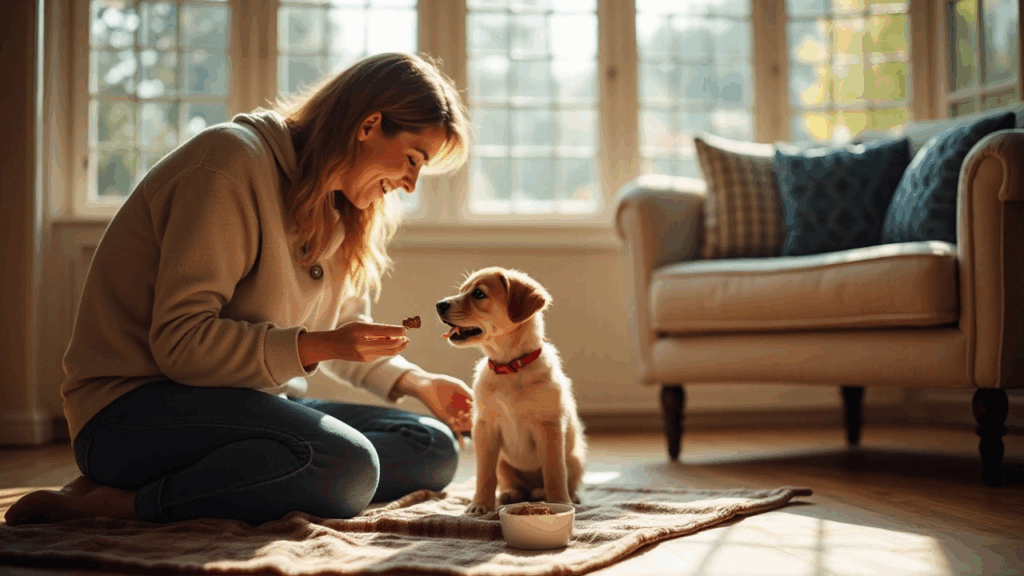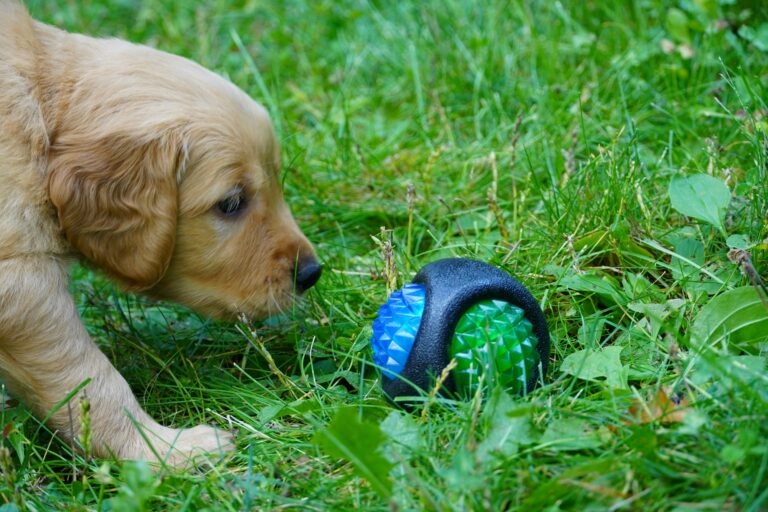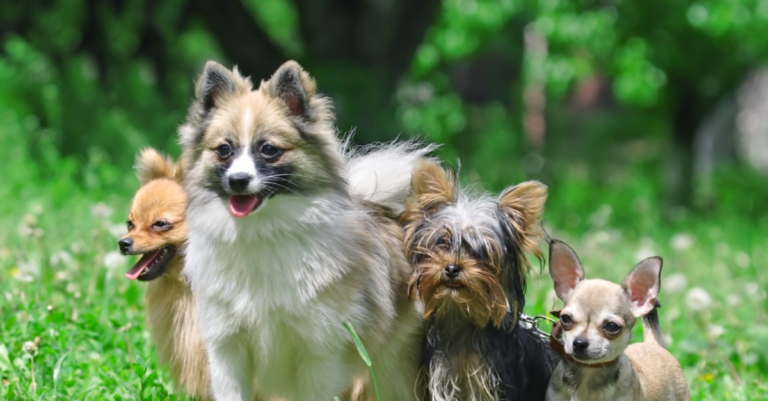Get ready for a deep dive into the world of Yorkie training! Your Yorkie pup is precious, full of life, and a bundle of relentless energy. Training them can sometimes feel like a herculean task but fear not, as this comprehensive guide on ‘Yorkie Training 101: Mastering the Art of Housebreaking Your Precious Pup’ is here to help you navigate through the nuances of this important phase in your pup’s life. Expect tips, tricks, and practical advice that will make the process of housebreaking your Yorkie a breeze.

In this guide, we will not only cover the basics of housebreaking your Yorkie but also equip you with the knowledge to understand their unique behavior. We will take you through the different stages of Yorkie training, highlighting common challenges you may face, and providing strategies to overcome them. This detailed guide is designed to make the journey of housebreaking your pup less daunting and more enjoyable for both of you.
Whether you’re a first-time Yorkie parent or an experienced dog owner looking for some additional tips, this guide is sure to be of assistance. You will gain insights into creating a conducive environment for your Yorkie’s learning, understanding their body language, and most importantly, fostering a loving bond with your precious pup through effective and empathetic training. So gear up, as we set forth on this exciting journey of housebreaking your Yorkie, one paw at a time. 🐾
Understanding Yorkie Behavior
Yorkshire Terriers, or Yorkies, are a beloved small dog breed admired for their big personalities in tiny bodies. Their unique blend of intelligence, tenacity, and loyalty makes them an exciting companion, but these same traits can make housebreaking particularly challenging. Yorkies tend to exhibit strong independence, which, although admirable, can lead to defiant behavior during training. This doesn’t mean they are untrainable—far from it—but they do require a consistent and patient approach.
One aspect to keep in mind is that Yorkies form strong attachments to their owners. This attachment is a double-edged sword when it comes to training. On the one hand, they are eager to please and responsive to attention; on the other, they may develop separation anxiety if left alone for long periods. This emotional state can contribute to potty accidents, especially if the dog becomes stressed when you leave the house.
Yorkies also have a tendency to mark their territory indoors, particularly unneutered males. This behavior is instinctive and may persist if not addressed early through training and, when appropriate, spaying or neutering.
Understanding their natural curiosity is also key. A Yorkie’s inquisitive nature often drives them to wander and explore new corners of your home. While this trait is endearing, it can sometimes lead to accidents if they are not under supervision or don’t yet understand where to relieve themselves.
The Importance of a Consistent Routine
Routine brings order to your Yorkie’s world. Since dogs are creatures of habit, providing structure helps reduce stress and sets clear expectations for behavior. Feeding your Yorkie at the same time each day contributes to a predictable digestive cycle, which in turn makes potty schedules easier to manage.
It’s recommended to take your Yorkie outside or to the designated potty area about 15 to 30 minutes after meals. This timing aligns with their natural digestive rhythm. Likewise, after naps and play sessions, your Yorkie should be offered a potty opportunity. Doing this consistently reinforces the pattern and teaches your pup when and where they are supposed to go.
Consistency extends beyond potty timing. Verbal cues, for example, should remain the same. If you use the phrase “go potty,” avoid switching it to “do your business” or “go pee.” Repetition helps solidify the connection between the command and the action you want.
Another helpful routine is creating a daily schedule that includes meals, playtime, potty breaks, and rest. Sticking to a daily rhythm helps reduce anxiety and encourages positive behaviors by giving your dog a sense of stability and predictability.
Environmental Setup for Successful Housebreaking
Setting up your home for housebreaking success is just as important as setting routines. Start by designating a specific area for your Yorkie to relieve themselves. This could be a patch of grass outside, a pee pad indoors, or even a faux grass potty system if you’re in an apartment.
Remove rugs and carpets from common accident areas until your dog has been consistently housebroken. Soft surfaces are often tempting for small dogs to urinate on because they absorb odors and feel comfortable under their paws.
Create a defined play and sleep area for your Yorkie. When not being directly supervised, limit their access to the whole house. This not only reduces the chance of hidden accidents but also reinforces the idea that certain places are off-limits for bathroom use.
Make sure your Yorkie always has easy access to their potty spot. In larger homes, this may mean placing multiple pads in different rooms until your dog is fully trained and understands to go to one consistent location.
The Power of Positive Reinforcement
Yorkies respond exceptionally well to praise and rewards. As part of your housebreaking strategy, keep a stash of small, healthy treats nearby so you can immediately reward good behavior. The timing of your praise is critical—rewards should come right after your dog relieves themselves in the appropriate spot.
Verbal praise, physical affection, and enthusiastic tones also go a long way. A cheerful “Good job!” or a gentle scratch behind the ears reinforces the behavior positively. Over time, your Yorkie will associate the correct potty behavior with positive outcomes.
It’s important to avoid punishing your dog for accidents. Harsh reactions may create fear or confusion, which can actually delay the housebreaking process. If you catch your Yorkie in the act, calmly redirect them to the correct spot without yelling or scolding.
Tracking Progress with a Potty Log
Keeping a training log may sound excessive, but it can be extremely helpful in spotting patterns and progress. Use a notebook or a simple spreadsheet to record when your Yorkie eats, sleeps, and eliminates. Include notes about accidents—when and where they happened, what might have caused them, and how you responded.
This information helps identify trends and can guide you in adjusting feeding schedules, recognizing bladder control improvements, and refining potty break timing. If your Yorkie always has accidents in the afternoon, perhaps a walk or bathroom break is missing from their routine.
Tracking also helps you stay motivated. Training can sometimes feel slow, but seeing steady improvements over days or weeks helps reinforce your consistency.
Socialization and Its Impact on Housebreaking
Socialization is often discussed in terms of behavior with people and other animals, but it can also play a vital role in housebreaking. A well-socialized Yorkie is more adaptable and less likely to be fearful or anxious in new situations, including using different potty areas when away from home.

Introduce your Yorkie to different environments where they are allowed to relieve themselves. If your routine includes travel or visits to friends and family, exposing your dog to new locations early on will help them generalize their potty training behavior and avoid confusion or regression.
Exposure to the outdoors—like grass, gravel, or pavement—is especially important if you’re transitioning from pads to outdoor elimination. Allow them to explore these surfaces regularly to get comfortable with relieving themselves in various conditions.
Common Behavioral Setbacks and How to Handle Them
Even with a solid plan, setbacks are normal. Yorkies may regress due to changes in their environment, such as a move to a new house, the introduction of a new pet, or schedule changes. Illness, stress, or dietary changes can also affect bathroom habits.
When setbacks occur, return to the basics. Reinstate a stricter schedule with more frequent potty breaks and supervision. Reinforce successes with praise and treats. If accidents continue despite your efforts, consult a vet to rule out medical issues like urinary tract infections or digestive problems.
Another common setback is distraction. Yorkies are naturally curious and may get caught up in exploring the yard or watching squirrels instead of doing their business. Try standing still during potty breaks, use a cue like “go potty,” and wait patiently. Once the job is done, then play or walk.
Crate Training Tips Specific to Yorkies
Crate training, when done correctly, is highly effective with Yorkies. The crate serves as a den—a secure space where your dog can rest and feel safe. Because dogs instinctively avoid soiling their sleeping area, crates help reinforce bladder control.
Start by introducing the crate gradually. Place a soft blanket, a chew toy, and a few treats inside to create a positive association. Leave the crate door open at first, allowing your Yorkie to explore without pressure. Once they are comfortable, begin using the crate for short rest periods.
Make sure the crate is the right size. Too large, and your Yorkie may designate one corner for pottying. Too small, and it may be uncomfortable. The correct size allows them to stand up, turn around, and lie down comfortably.
Use the crate during times when you can’t supervise your dog directly. Just be sure to give them a potty opportunity before and after crating. If you use the crate overnight, be prepared for early morning potty needs, especially for puppies under six months.
Housebreaking Techniques
There are several methods you can use to housebreak your Yorkie. These include crate training, paper training, and bell training.
Crate Training
Crate training is a popular method because it taps into a dog’s natural instinct not to soil their sleeping area. The key to successful crate training is to ensure the crate is not too big. It should be comfortable for your Yorkie to sleep, but not big enough for them to use a corner as a bathroom.
Remember, the crate is not a punishment, but a safe space for your Yorkie. Never use it as a form of punishment.
Paper Training
Paper training is another method often used, especially for Yorkies that live in high-rise apartments where getting outside quickly is not an option. This method involves training your Yorkie to use newspapers or puppy pads as their bathroom. It requires a lot of patience and consistency.
Bell Training
Bell training involves teaching your Yorkie to ring a bell when they need to go outside. This can be especially useful if you are in a different room and may not see the usual signs that your Yorkie needs to go out.
Common Housebreaking Mistakes to Avoid
It’s essential to avoid certain mistakes during the housebreaking process. These mistakes can prolong the process and lead to frustration for both you and your Yorkie.
Punishing Accidents
It’s important to remember that accidents will happen. However, punishing your Yorkie for these accidents can lead to fear and anxiety, which can actually make housebreaking more difficult. Instead, clean up accidents calmly and quietly, using an enzymatic cleaner to remove any lingering smells.
Inconsistent Routine
Inconsistencies in your Yorkie’s routine can lead to confusion and make housebreaking more challenging. Ensure that meal times, play times, and bathroom breaks are kept consistent.
Housebreaking Aids and Tools
There are several tools and aids you can use to assist in housebreaking your Yorkie. These include:
- Enzymatic Cleaners: These are used to clean up accidents and remove any lingering smells that may encourage your Yorkie to use the same spot again.
- Crate: A well-sized crate can be a useful tool in housebreaking your Yorkie.
- Treats: Treats can be used as a positive reinforcement when your Yorkie goes to the bathroom in the correct place.
Remember, housebreaking your Yorkie will require patience, consistency, and understanding. But with the right approach and tools, your Yorkie will be housebroken in no time.
Conclusion
In conclusion, mastering the art of Yorkie training, specifically housebreaking, is a crucial step for every pet owner. This process takes patience, consistency, and understanding to successfully create a comfortable environment for your precious pup. It’s also key to remember that every Yorkie has its unique personality, and adjusting your training methods accordingly will yield the best results.
Utilizing positive reinforcement in the form of treats and praises for good behavior will encourage your Yorkie to repeat those actions. On the other hand, accidents should be handled with patience, reinforcing the correct behavior instead of punishing the mistake. Regular routines, like feeding and walking times, are also essential in housebreaking your Yorkie, as it provides them with a sense of security and helps anticipate their needs.
By following these Yorkie training 101 guidelines, you’ll be on your way to creating a happy, healthy, and well-behaved environment for your pup. Remember, the process may be slow, but it is worth every effort to develop a strong bond with your furry friend. Housebreaking is not just about training your Yorkie, but also about building an understanding relationship based on love and trust.
Overall, the art of Yorkie training is a rewarding journey that results in an obedient, well-adjusted, and affectionate pet, making your life as a pet owner that much more enjoyable. 🐾🏠🐶



